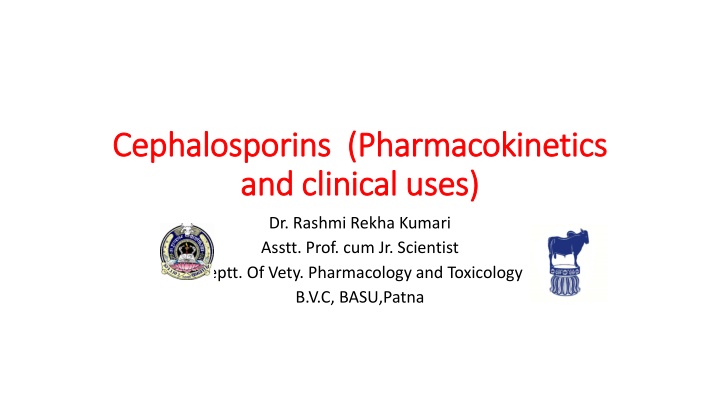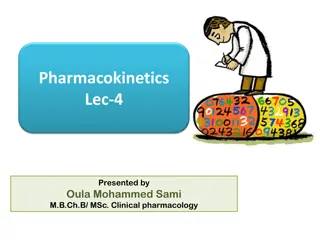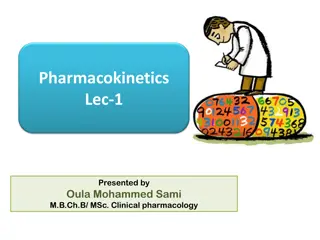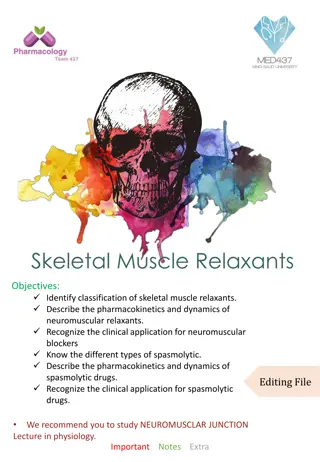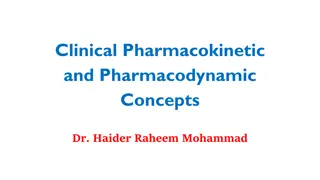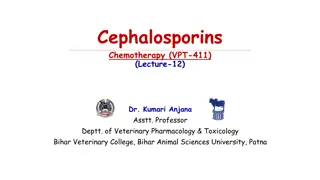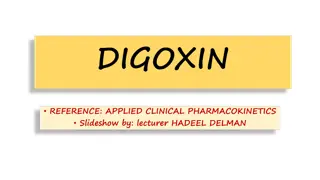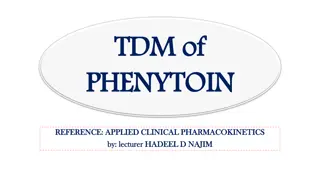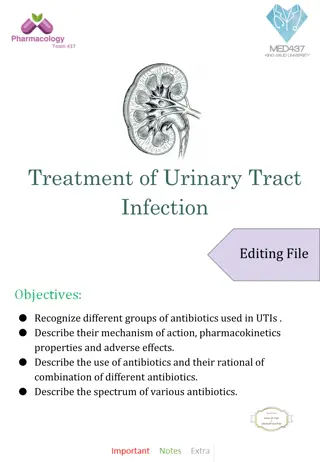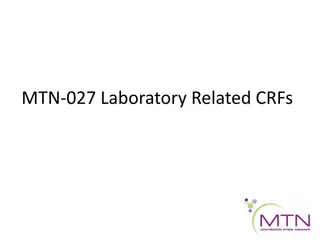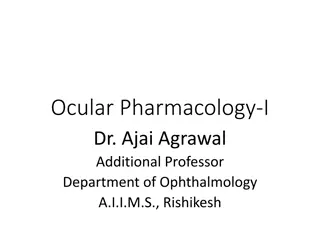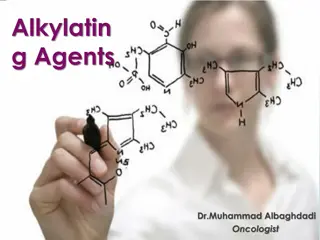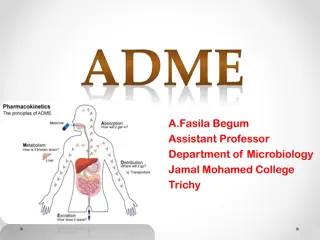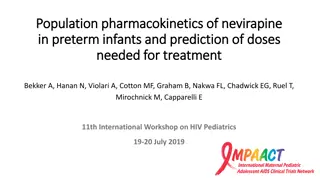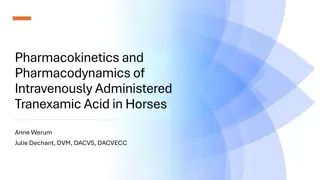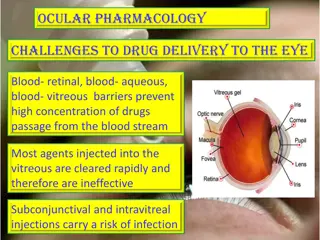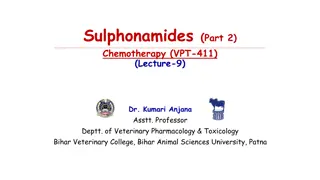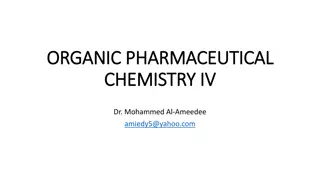Cephalosporins: Pharmacokinetics and Clinical Uses
Cephalosporins are antibiotics used in veterinary medicine for bacterial infections. They have short half-lives, requiring frequent dosing, but some third-generation ones have longer half-lives. They show good distribution in extracellular fluids of tissues, but poor penetration into certain areas like the CNS. Metabolism is minimal, with renal elimination. Specific drugs like cephalexin and cephadroxil are commonly used in dogs for various infections. Dosage recommendations for different species are provided.
Download Presentation

Please find below an Image/Link to download the presentation.
The content on the website is provided AS IS for your information and personal use only. It may not be sold, licensed, or shared on other websites without obtaining consent from the author.If you encounter any issues during the download, it is possible that the publisher has removed the file from their server.
You are allowed to download the files provided on this website for personal or commercial use, subject to the condition that they are used lawfully. All files are the property of their respective owners.
The content on the website is provided AS IS for your information and personal use only. It may not be sold, licensed, or shared on other websites without obtaining consent from the author.
E N D
Presentation Transcript
Cephalosporins Cephalosporins (Pharmacokinetics (Pharmacokinetics and clinical uses) and clinical uses) Dr. Rashmi Rekha Kumari Asstt. Prof. cum Jr. Scientist Deptt. Of Vety. Pharmacology and Toxicology B.V.C, BASU,Patna
Pharmacokinetics Pharmacokinetics Half life of most cephalosporins in mammals are short, therefore, many regimens for cephalosporin use require an administration frequency of three to four times per day Alternatively, some of the third generation cephalosporins have long half life and less frequent regimen have been used for these. Example; cefpodoxime,cefovecin, cefotaxime and ceftiofure Ceftriaxone have long half-life in human but not in animal due to differences in plasma protein binding.
Tissue concentration and protein binding Tissue concentration and protein binding Cephalosporins are relatively polar antibiotics, they are minimally lipid soluble and have poor intracellular penetration. The volume of distribution is generally in the range of 0.2-0.3 l/kg and rarely exceeds0.5 l/kg But they have good distribution in extracellular fluid of most tissues, except prostate and CNS Some third generation cephalosporins are exception Plasma protein binding for most cephalosporins is low in companion animal compared to human. Drug PPB in human PPB in Dog Cefrtiaxone 90-95% 25% Cefazolin 85% 19%
Cefovecin highly plasma protein bound in Dog and cat(99%) Metabolism: Cephalosporins are minimally metabolised by the liver, but degree of metabolism can vary among various drugs. Route of elimination is primarily renal and concentration in urine is high-good choice for treatment of UTI. In general most cephalosporins have half life 1-2 hr., but some third generation cephalosporin have longer half life.(Ceftiofur metabolised in active metabolite- desfluroylceftiofur.
Clinical features and specific drugs used in vety. medicine Used for treatment of bacterial infection that are resistant to other drug The bacteria often identified in these resistance problem is E. coli, Klebsiella pneumoniae, Enterobactor species, proteus specie(especially indole positive) and pseudomonas aeruginosa First generation cephalosporins Cephalexin and cephadroxil have been the most extensively used of oral first generation cephalosporins in Dog. Cephadroxil: Used for treatment of UTI, skin infection, respiratory infection. Use in Skin infection is most common use
Dose( pyoderma) in Dog: 22mg/kg every 12hrs orally for 21to 30 days Cat : 20mg/kg twice a day Cephalexin: have been found equally effective in superficial and deep pyoderma as cephadroxil at a dose of 22-35mg/kg twice daily for atleast 3 weeks. Horse: 30mg/kg q8h orally. Cefazolin: Injectable cephalosporins most often used in small animals Has low ppb(19% in dog) diffuses to tissue fluid at concentration parallel to those in plasma Also penetrate normal as well as osteomyeletic bone. The advantage of good penetration in normal as well as osteomyeletic bone has allowed it for prevention and treatment of bone infection. IT is a common antibiotic to be used prophylactically before orthopaedic surgery.
Dog: 22mg/kg IV every 2hr or 8mg/kg IV every hr for infection of bone or prophylaxis of orthopaedic surgery Cefazolin also used in large animal. Horse; 10-20mg/kg can be administered q8h IM or q6h IV. Second generation cephalosporins Cefoxitin and cefotetan most often used in vety. Medicine. Used for treatment of organism resistant to first generation and anaerobic infection( Bacteroid fragalis group) Anaerobic bacteria Bacteroid fragalis sythesises cephalosporinase enzyme, but cefoxitin and cefotetan, belongs to special group cephamycin, are resistant to these antibiotics.
Therefor these drug are valuable for some cases such as septic peritonitis that may have a mixed population of anaerobic and gram- ve bacilli. Dose: 30mg/kg every 8 hr IV Third generation cephalosporins Cefotaxime: Most frequently administered. Dose in dog and cat:30mg/kg, IM,IV or SC every 8 hr. Ceftiofur: registered for treatment of UTI caused by enterobacteriacae in dog at a dose rate of 2.2 mg/kg body wt.
Ceftiofur: Most frequently used cephalosporins in horse. Approved for treatment of respiratory tract infection caused by Streptococcus equi subsp zooepidemicus at a dose of 2.2 to4.4 mg/kg q24hr IM For inherently more resistant organism klebsiella, enterobactor, salmonella higher doses or more frequent administration is required Other major use of ceftiofur is for cattle and pig. It has been used for treating respiratory infection(BRD) in cattle(1-2mg/kg q24hr) caused by Mannheimia haemolytica (formerly called Pasteurella haemolytica), Pasturella multocida.
Ceftazidime: Have a good activity against Enterobacteriacae and Pseudomonas aeruginosa Compared to other cephalosporins, ceftazidime is most active against Pseudomonas. Cefoperazone also active against cephalosporins. Dosages have ranged from 20-30mg/kg every 12hr for enterobacteriaceae, to 30mg/kg administered every four hr for Pseudomonas. Cefovecin: Terminal half life of cefovecin appx 7 days in cat and 5 days in dog. Long half life is due to high plasma protein binding >99% protein bound in catand > 98% in dog. Cefixime: oral 3rdgeneration with long half life. This is due to high PPB, 82- 92%. Administered once daily or twice daily @ 5mg/kg.
Summary of Clinical Uses Summary of Clinical Uses I Generation cephalosporins are used as alternative to penicillin G in Staphylococcal infection (cephalexin) and for surgical prophylaxis (cefazolin). Ceftiofur is specifically used in bovine bronchopneumonia caused by P.multocida or P. haemolytica and urinary tract infection in dogs. Cephalosporins are useful in treating infections of soft tissues and bones, meningitis, osteomyelitis, prostatitis, arthritis and urinary tract infections. Cephapirin benzathine (in dry cows) and cephapirin sodium are used in the treatment of mastitis.
